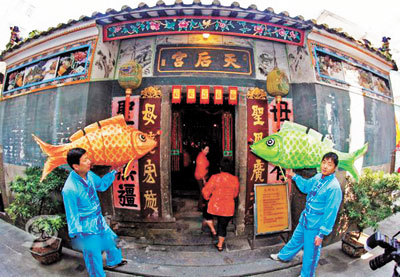
Wang Yuanyuan
cheekywang@hotmail.com
MORE than 10 organizations were invited to perform and lead activities during this year’s Shatoujiao Fish Lantern Festival, held Sept. 17 and 18 in Yantian District.
Participants were national-level intangible cultural heritage groups, including a lion dance team from Songgang, a fish lantern performance team in Shatoujiao and a performance troupe from Putian, Fujian Province.
Other traditional ceremonies included a Mazu worship ceremony conducted by villagers in Shatoujiao and Hong Kong, said Huang Jin’an, curator of Zhongying Street Museum in Yantian District.
“Different from last year’s festival, this year we invited Wu Tianyang — the only Shatoujiao villager who knows how to make fish lanterns in traditional ways — to make lanterns used for performances, bringing the festival much closer to ancient traditions,” Huang said.
Fish lantern dances originated in Shatoujiao around the end of the Ming Dynasty (1368-1644). They were once very popular in Shenzhen villages in Shatoujiao and Yantian, and in Hong Kong’s New Territories.
In 2003, the Ministry of Culture designated 90 locations as “homes of Chinese folk arts” and “homes of special Chinese folk arts.” Shatoujiao made the list because of its unique dances. The Zhongying Street Museum displays precious instruments that were used for the dances in the 1930s.
Huang said performing the dances long has been one of the most important traditions for villagers during the annual Spring Festival and Lantern Festival. Fishermen dance together with homemade fish lanterns, creating a grand lantern fair.
Instruments played for the dances include gongs, drums, flutes and erhus. Dancers carry lanterns that look like fish, turtles, shrimp and crabs, recreating fishing scenes with quick movements. Popular scenes include reeling fish in and battling with fish caught on lines.
There are more than 20 types of fish lanterns in Shatoujiao. The colorful paper lanterns of different sizes and shapes create an art form with a unique style.
Shalanxia Village in Shatoujiao is the city’s most well-known village for fish lantern dances. The village has more than 170 years of fish lantern dance tradition, and its residents have been invited to perform in Shenzhen and Hong Kong at major events and celebrations.
The dances gradually disappeared in the village since the 1950s, but in 2003, Shatoujiao Subdistrict leaders invested 100,000 yuan (US$16,000) to revive the dances in the village. Over the past 10 years, the city’s government has made additional investments to protect and promote the dances and train dancers.
The subdistrict also launched a program this year to teach traditional lantern-making techniques, with Wu invited to lead the instruction.
|

